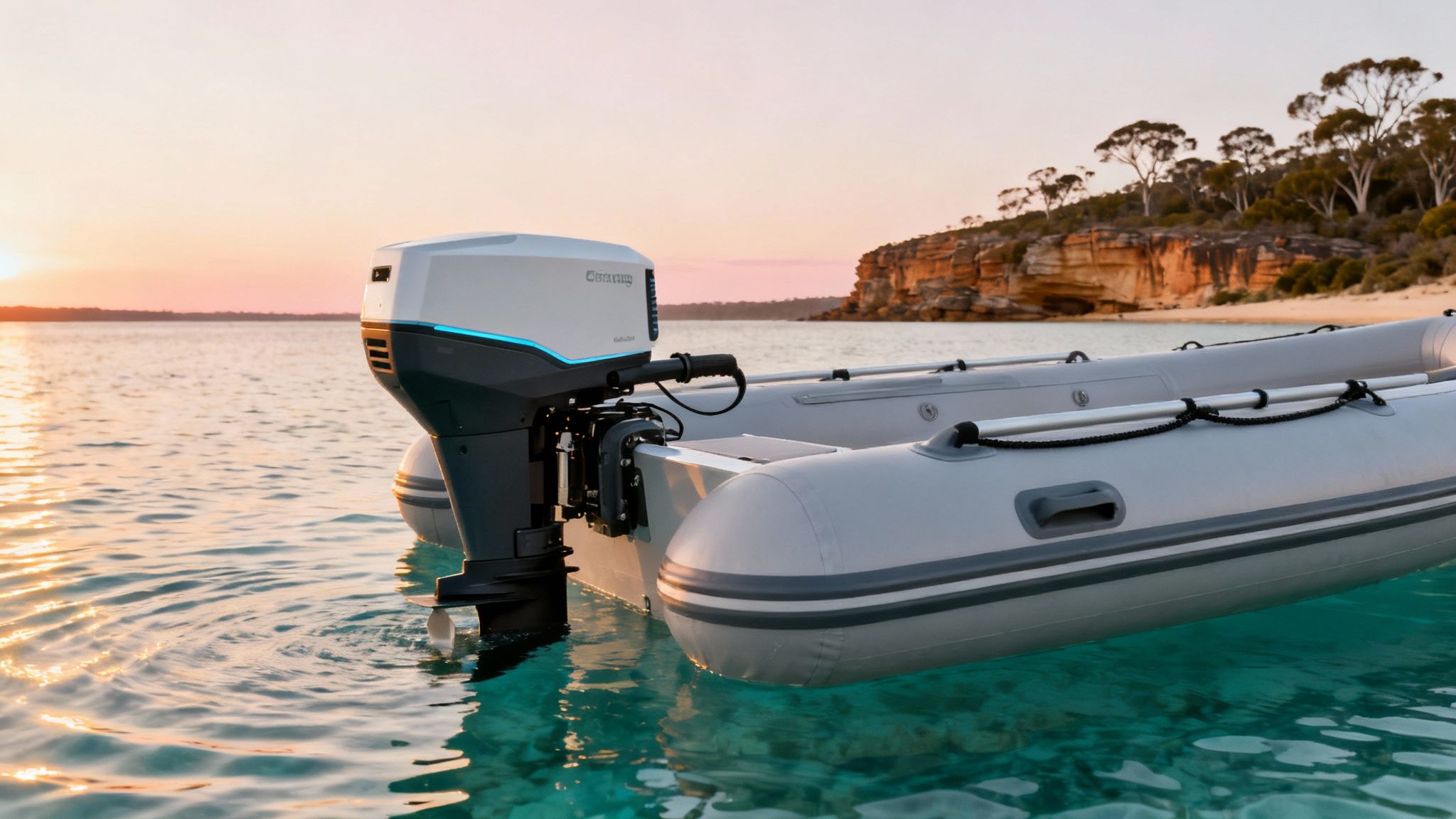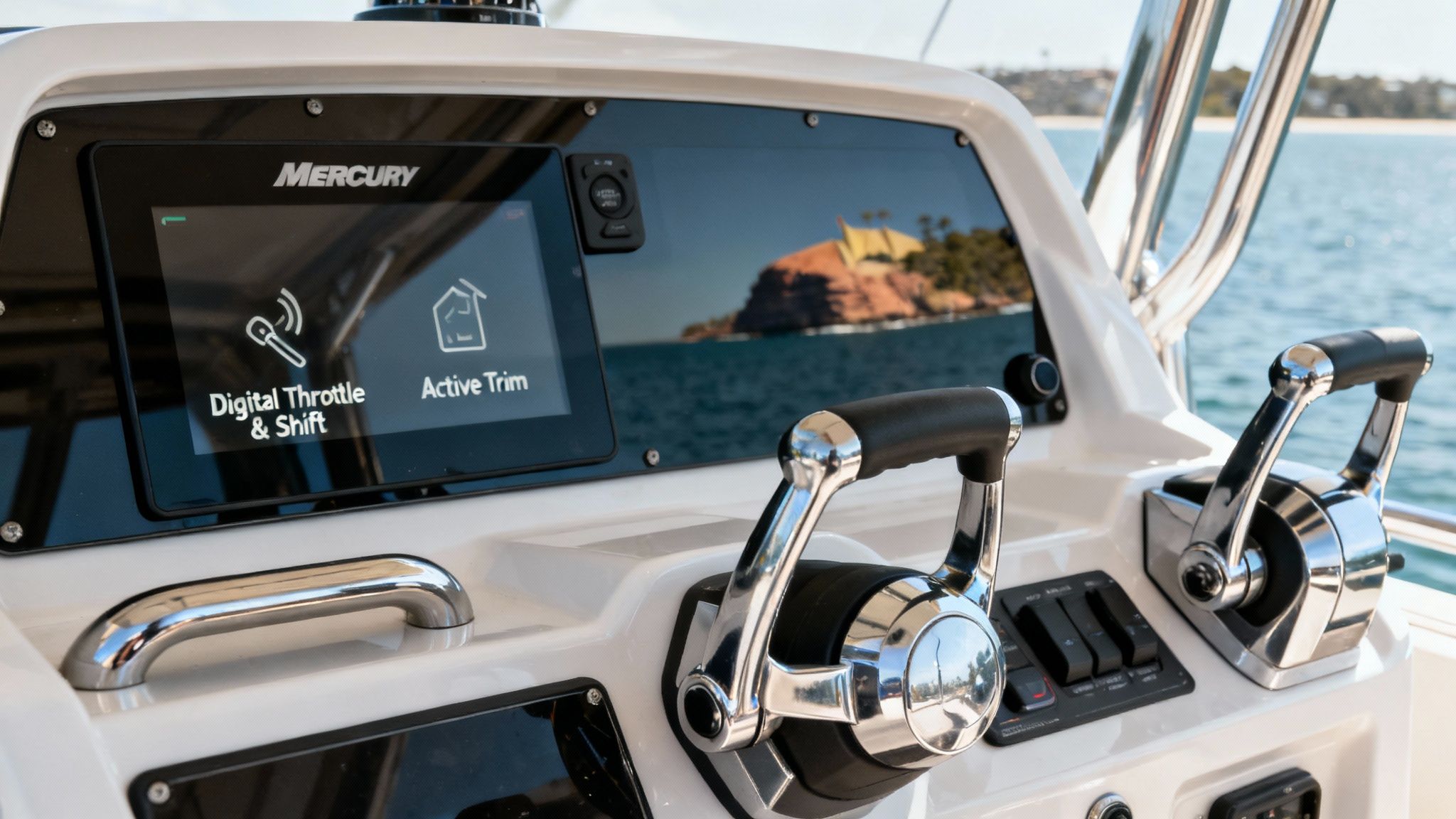
When you’re picking an outboard for Australian waters, one name consistently rises to the top: Mercury Marine. Whether you’re pottering around quiet estuaries or tackling demanding offshore conditions, their engines are built for the job. They’re specifically engineered for our harsh saltwater environment and backed by a massive dealer network, so you’re never far from support.
It’s this blend of smart innovation and solid local backing that makes Mercury such a trusted partner for Aussie boaters.
Step onto any Aussie waterway, and you’ll see the iconic Mercury logo on the back of countless boats. That’s no accident. It’s the result of a long-earned reputation for building engines that don’t just survive our local conditions—they thrive in them. For decades, Australian boaters have put their trust in Mercury for powerful performance and rock-solid reliability.
You can see that trust in the numbers. At the recent Sydney International Boat Show, Mercury engines were on an incredible 50% of all outboards on display—more than double their closest competitor. That kind of market dominance tells you everything you need to know about the confidence boat builders and seasoned mariners place in the brand. You can explore more details about Mercury’s market performance on their official news page.
So, what makes Mercury the go-to choice for so many? It really boils down to a few key things that just click with the Aussie boating lifestyle:
Choosing an outboard isn’t just about horsepower; it’s about investing in hassle-free time on the water. Mercury’s combination of robust engineering and a strong support network provides peace of mind for every trip.
Whether you’re fitting out a small tinny or a big offshore rig, understanding these fundamentals is key. It’s also why pairing the right engine with the right hull is so important, a topic we cover in our guide to the best inflatable boats in Australia. This strong foundation is why a direct comparison against competitors like Hidea often reveals the deeper value Mercury offers beyond the initial price tag.
Choosing the perfect engine for your boat can feel like a massive task, but Mercury has made it simple by organising their range into distinct series, each built for a specific job on the water. For us here in Australia, that means there’s a Mercury outboard perfectly suited for everything from chasing bream in a quiet estuary to tackling serious offshore adventures.
It’s a bit like picking the right vehicle for a job. You wouldn’t use a zippy little city car to tow a caravan, and you wouldn’t take a semi-trailer for a quick run to the local shops. Mercury’s lineup works on the same common-sense logic, making sure you get the right power, features, and durability for exactly what you need.
So, where do you start? The first step is to think about how you actually use your boat. Are you flicking lures for flathead in a small tinny, towing the kids on a ski biscuit, or running a commercial charter day in, day out? Your answer will point you straight to the right Mercury series.
Let’s take a look at the core of the Mercury outboards Australia range. To make it easier to see how they stack up, here’s a quick-reference table.
| Mercury Series | Horsepower Range | Ideal For | Key Feature |
|---|---|---|---|
| FourStroke | 2.5–150 hp | Tinnies, tenders, family runabouts, coastal cruising | Quiet operation and fantastic fuel economy |
| SeaPro | 15–500 hp | Commercial fishing, charter boats, water taxis, high-hour recreational use | Unbeatable durability and simplified maintenance |
| Verado | 250–600 hp | High-performance offshore boats, premium cruisers, serious sportfishing | Smooth, refined power and cutting-edge digital technology |
This table gives you a great starting point, showing how each series is designed with a different boater in mind. Whether you need an efficient all-rounder, a tough-as-nails workhorse, or the pinnacle of performance, there’s a clear choice.
This infographic helps visualise that first decision.

Once you know you need an engine, Mercury becomes the obvious next step.
Let’s put this into practice with a few common Aussie boating scenarios.
A keen angler with a 4.2m aluminium tinny exploring Sydney’s Pittwater would find a 30hp FourStroke is the perfect match. It offers whisper-quiet trolling for sneaking up on fish and has more than enough grunt to get you home safely.
Meanwhile, a family with a 6m bowrider used for wakeboarding on the Gold Coast Broadwater would get a huge benefit from the punchy acceleration of a 150hp FourStroke.
For the incredibly popular smaller inflatable boats, matching horsepower is absolutely crucial for both performance and safety. If you’re looking to power a tender or a compact fishing setup, you can learn more about finding the right 20 hp outboard engine and see how it pairs with different inflatable hull designs.
Matching the engine’s weight and power to your boat’s transom rating is non-negotiable. An oversized engine can seriously compromise handling and safety, while an underpowered one will struggle, leading to frustrating performance and guzzling more fuel than it should.
Ultimately, the best Mercury outboards Australia has to offer are the ones that perfectly complement your vessel and your passion. By starting with your boating style and understanding what each series is built for, you can confidently choose an engine that will deliver rock-solid performance for years to come.
When you’re in the market for a new outboard in Australia, two names often pop up for very different reasons: the established giant, Mercury, and the budget-friendly challenger, Hidea. It’s a classic showdown between proven performance and a compelling price tag.
The right choice for your boat depends entirely on what you value most. This isn’t just about the initial cost; it’s about the total ownership experience. For many Aussie boaters, an outboard is a massive investment, so deciding between these two means weighing up-front savings against long-term reliability and the critical safety net of a robust support network.
At their core, the two brands have completely different engineering philosophies. Mercury has poured millions into advanced platforms like their V6 and V8 FourStrokes, which sit at the forefront of outboard technology. These engines are all about smooth power, impressive torque, and exceptional fuel efficiency, using complex systems to squeeze the most out of every drop of fuel. When you see a Mercury on a boat, you know it’s a premium product built on decades of innovation.
Hidea, on the other hand, keeps things simple with proven, straightforward designs based on older, well-established technology. This approach keeps their costs down. While this simplicity can be a real advantage if you’re a fan of DIY maintenance, it means they generally don’t offer the same level of refined performance, quiet operation, or fuel economy you’ll find in Mercury’s more modern powerheads.
In the harsh Aussie saltwater environment, reliability is everything. Mercury outboards Australia are built with this in mind, using advanced anti-corrosion materials like their XK360 low-copper aluminium alloy and a tough multi-layer paint process. This relentless focus on durability is a huge part of their rock-solid reputation and why they hold their value so well.
While Hidea offers an affordable way to get on the water, Mercury’s legacy is built on engines that endure years of tough use. The total cost of ownership often swings in Mercury’s favour through better fuel economy, higher resale value, and fewer surprise repair bills down the track.
This reputation is backed by the numbers. In the competitive Australian marine sector, Mercury Marine saw its brand consideration grow by 6.3%, a testament to its strong dealer network and product dependability resonating with local boaters. This growth happened as the total outboard market hit $450.5 million in sales, showing that even with budget options around, many Aussies still prioritise proven quality. For those exploring budget-friendly alternatives, our deep dive into Hidea outboard motors offers a value-driven perspective.
This is arguably the biggest difference between the two and a major factor for Australian boaters. Mercury has a massive, well-established network of authorised dealers and service centres covering almost every corner of Australia. If you run into trouble in a remote coastal town, there’s a very high chance you’ll find genuine parts and a qualified tech nearby.
Hidea’s network is much smaller and still growing. While their dealers provide essential support, the sheer scale of Mercury’s presence gives you an unmatched level of security and convenience, especially if you love to travel with your boat. Waiting weeks for a part to arrive from overseas can completely ruin a fishing trip or a family holiday. With Mercury, that’s rarely a concern.
Choosing between these two really comes down to your budget versus your long-term needs. Here’s a quick breakdown of how they stack up for the average Aussie boater.
| Feature | Mercury | Hidea |
|---|---|---|
| Technology | Advanced systems like DTS, Active Trim, and VesselView. | Basic, mechanically focused designs based on older technology. |
| Fuel Efficiency | Generally superior due to modern engine design and electronic controls. | Typically less efficient, reflecting simpler and older designs. |
| Service & Parts | Extensive nationwide dealer network for easy access to parts & service. | A smaller, developing network, with parts availability less certain. |
| Resale Value | Holds value exceptionally well due to brand reputation and reliability. | Lower initial cost often results in faster and steeper depreciation. |
| Initial Price | Higher upfront investment reflecting advanced R&D and build quality. | Significantly lower, making it an attractive option for budget buyers. |
Ultimately, the choice between Mercury and Hidea is a trade-off. Hidea makes getting on the water more accessible with its low initial price point. However, for the serious Australian boater, Mercury offers a more complete package of performance, efficiency, and unbeatable support that often translates to better long-term value and peace of mind.

Today’s Mercury outboards are much more than just powerful engines. They’re intelligent, connected systems designed to make your time on the water smoother, safer, and far more enjoyable. While competitors might stick to basic mechanical simplicity, Mercury has gone all-in on smart technology that completely changes the boating experience.
These features aren’t just shiny gimmicks—they offer real, practical advantages for Aussie boaters.
Think of these innovations as an expert co-pilot. Instead of you constantly fiddling with controls to get the best performance, Mercury’s systems work quietly in the background, handling the complex tasks for you. This means you can focus less on managing the engine and more on the adventure itself, whether that’s navigating a tricky channel or chasing a school of fish.
One of the biggest leaps forward is Mercury’s Digital Throttle & Shift (DTS) system. If you’ve ever driven an older boat with clunky mechanical cables, you’ll know that wrestling match feel when you shift gears or try to find the perfect throttle position. DTS changes all of that.
The best way to think about DTS is like the ‘drive-by-wire’ system you’d find in a modern high-performance car. There are no physical cables linking your hand to the engine. Instead, your commands are sent electronically, giving you instant, silky-smooth gear changes and incredibly precise throttle control.
Another game-changing feature is Active Trim. Manually adjusting your engine’s trim can be a constant hassle, especially as your speed, water conditions, and even the number of passengers change. Get it wrong, and you’re just burning extra fuel and sacrificing performance.
Mercury’s Active Trim is basically an ‘auto-pilot for your engine trim.’ It uses GPS data and engine RPM to automatically and continuously adjust the trim angle for peak performance. You just set it once and forget it.
This means you’re always running at the most efficient angle, saving fuel and delivering a better ride without you ever needing to touch a button. For boaters exploring Australia’s vast waterways, this translates directly into real fuel savings and a more comfortable journey every time.
These smart systems are just one reason why Mercury outboards Australia has become a leader in marine propulsion. As technology continues to push forward, you can explore what’s next with our insights on the Mercury electric outboard lineup and see how it’s changing the game for smaller boats. This fusion of smart technology ensures a more intuitive and efficient day on the water, every time you leave the ramp.

Buying a new outboard is just the start. The real test of a brand is the support you get after the sale—the network that keeps you on the water, trouble-free. For owners of Mercury outboards in Australia, this isn’t an afterthought; it’s one of their biggest strengths. It’s the confidence of knowing that wherever your adventures take you, expert help is always within reach.
This all starts with Mercury’s massive authorised dealer network. Don’t think of these as just showrooms. They are your local partners for everything from the initial rigging and genuine parts to expert servicing and warranty claims. Having this national footprint is a game-changer, especially when you’re in a remote coastal town and can’t afford to wait weeks for a critical part.
Finding your nearest expert couldn’t be easier. Mercury Marine Australia has a simple dealer locator on their website, putting you in touch with certified technicians who live and breathe these engines. This network is the true backbone of the ownership experience.
The quality of this network shines through in their annual awards, which celebrate the best in sales and service. Take Tasmania’s Channel Marine, for instance—they made history by becoming the first Tassie dealer ever to be named Mercury Dealer of the Year. Their success, which included convincing local fish farms to switch to Mercury power, shows just how much trust both commercial and recreational boaties put in the brand and its local reps. You can read more about their big win and what it means for the local community.
While professional servicing is non-negotiable, a few simple habits will dramatically extend the life of your outboard, especially in our harsh saltwater environment. It’s all about consistent, basic care.
Here are the absolute must-do tasks for every Aussie Mercury owner:
Consistent maintenance is your best weapon against the corrosive power of the ocean. A five-minute flush after each trip can literally save you thousands in long-term repair bills.
Sticking to these simple routines, combined with regular servicing from an authorised dealer, will keep your Mercury ready for anything. And when you do need a spare, using a trusted supplier for genuine Mercury outboard parts means you’re getting the right component for the job, protecting your engine’s performance and reliability for years to come.
When you’re looking at outboards, especially for Aussie waters, you’re bound to have a few questions. We get it. To help you out, here are some of the most common queries we hear from boaters around the country, answered straight up.
Absolutely. In fact, they’re built for it. Mercury doesn’t just dabble in corrosion resistance; they pour a huge amount of their engineering budget into it. They use advanced materials like their exclusive XK360 low-copper aluminium alloy and a multi-stage paint process that seals the engine off from the harsh saltwater environment.
On top of that, they use strategically placed sacrificial anodes. These are designed to corrode first, taking the hit so the critical parts of your engine don’t have to. For any owner of Mercury outboards Australia-wide, the best way to guarantee a long, trouble-free life is simple: give it a good freshwater flush after every trip.
The price difference between a Mercury and a Hidea really comes down to a gap in technology, research, and infrastructure. When you buy a Mercury, that higher initial cost is an investment in world-class engineering, top-tier build quality, and a massive dealer and service network that covers just about every corner of Australia.
While a Hidea gets you on the water for less upfront, a Mercury often delivers far greater long-term value. You’ll see it in better fuel efficiency, a much stronger resale value, and the priceless peace of mind knowing that parts and expert support are always close by, no matter where your adventures take you.
Mercury Marine Australia sells its motors through a network of authorised dealers, and for good reason. The final price isn’t just for the engine in a box; it includes professional installation, rigging, controls, and propellers—all perfectly matched to your specific boat.
The best and most reliable way to get an accurate, all-in quote is to jump on the official Mercury Marine website and find your nearest authorised dealer. They’ll take a look at your boat, discuss what you need, and give you a detailed breakdown of the total cost to get you on the water properly and safely.
For almost every pre-mix two-stroke Mercury outboards Australia has seen over the years, the gold standard is a 50:1 ratio. In practical terms, that means you mix 100ml of quality TCW-3 rated two-stroke oil for every 5 litres of unleaded fuel.
This ratio provides fantastic lubrication for the engine, especially under the kinds of loads we put on them here in Australia. While you might hear about other brands recommending leaner mixtures, sticking to the 50:1 ratio for your Mercury is a tried-and-true formula for reliability and a long engine life. Always go for a high-quality, marine-specific two-stroke oil to give it the best protection possible.
Ready to power your next adventure with a reliable, portable, and value-packed boat? At Easy Inflatables, we specialise in creating the perfect rig for Australian waters. Explore our range of Aerowave inflatable boats and authorised Hidea outboard packages today.
Find Your Perfect Boat and Motor Package at Easy Inflatables
Experience the ultimate freedom on the water with our top-quality inflatable boats and accessories. Easy Inflatables is your trusted partner, providing everything you need for a safe and unforgettable adventure.
At Easy Inflatables, we believe in empowering adventurers with high-quality inflatable solutions. Our commitment to durability and performance ensures that every product enhances your outdoor experiences.